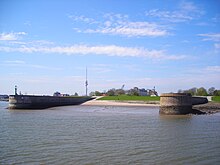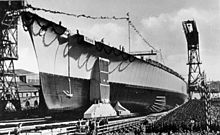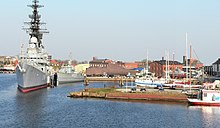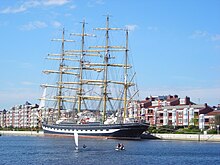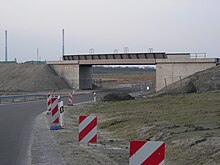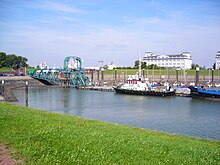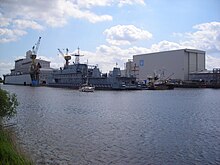Wilhelmshaven ports
The Wilhelmshaven ports consist of various port facilities in the area of the city of Wilhelmshaven , which are subdivided from the city area to the north - according to the historical development - in: city port , north port , naval base Heppenser Groden , NWO oil port , Lower Saxony bridge (coal discharge), transshipment facility Voslapper Groden (ethylene and other chemical raw materials), and Container Terminal Wilhelmshaven (CTW) in the port and logistics area JadeWeserPort . There are also small ports on the Jade Bay .
Economical meaning
Wilhelmshaven has the seaport with the greatest depth in Germany and is the largest oil transshipment port in the country. A total of 80% of the crude oil handling of all German seaports and almost 28% of the German crude oil imports are handled via Wilhelmshaven. Oil pipeline connections to refineries in the Rhine-Ruhr area and to Hamburg run from here . After the Port of Hamburg and the ports of Bremen, the ports of Wilhelmshaven have the third largest handling of all German seaports (29.3 million tons in 2019; 2017: 30.3 million t; 2016: 26.2 million t; 2015: 29 Million t; 2014: 24.2 t; 2013: 24.5 million t). In 2017 this included 20.3 million t of liquid bulk goods (2013: 19.5 million t), 4.2 million t of solid bulk goods (2013: 4.4 million t - mostly coal), 5.84 million t. t general cargo (2012: 27,271 t), which include container handling.
In 2013, 76,117 TEU were handled in the Wilhelmshaven Container Terminal (CTW) at JadeWeserPort , and in 2014 it was only 67,076 TEU. Since 2015, the JadeWeserPort has also been regularly called by container ships in liner service, container throughput at the CTW was 426,751 TEU in 2015, 481,720 TEU in 2016, 554,449 TEU in 2017, 655,790 TEU in 2018 and 639,084 TEU in 2019.
The deep waterway of the Inner Jade shapes the economy and is the basis for the settlement of large companies in the petrochemical industry , the chemical industry , the electricity-generating industry and other maritime industries (repair yards, ship equipment, etc.).
In Wilhelmshaven, the Heppenser Groden naval base is the largest naval base in Germany and one of the largest naval bases in Western Europe.
History of the Wilhelmshaven ports
Preliminary remark: The designation of individual parts of the port has changed in the course of time. The official names in use today are used here.
The founding of Wilhelmshaven goes back to Prussia's plan to set up a naval base on the North Sea . To this end, in 1854 Oldenburg acquired a small area known as the jade area , on which the city of Wilhelmshaven was established in addition to the military port facilities. The Imperial Constitution of 1871 designated the "Jade Harbor" as the Imperial War Port . Since then, the history of the city of Wilhelmshaven has been closely linked to the formation and development of the German Navy . At the beginning there were several communities outside the Prussian city of Wilhelmshaven that belonged to the state of Oldenburg and on whose territory part of the port facilities was located. From 1911 they formed the town of Rüstringen , which was united with Wilhelmshaven in 1937.
In the initial phase of the port construction, only those systems were built that were needed for the Navy. They were built as a tide-protected inner harbor that could be reached via various locks . Civil port facilities were not provided and were not wanted by the Navy. It was not until the navy was greatly reduced in size after the First World War that the question of the civilian use of facilities that had become vacant arose, and economic port activities slowly gained in importance.
Wilhelmshaven-Rüstringer Industriehafen- und Lagerhaus AG (Wrihala) was founded as a management company in 1925 after lengthy negotiations between the Reich, the states of Prussia and Oldenburg and the cities of Wilhelmshaven and Rüstringen . The Reich had tied far-reaching conditions to the provision of its facilities, which impaired economic activity as well as the global economic crisis that began in 1929 . When the navy developed a greater need for port facilities again after 1933, the dissolution of the Wrihala was initiated. Many facilities were returned to the Reich and the company ceased operations in 1934.
Another phase of expansion began before World War II . After the end of the war, extensive destruction and dismantling took place by the British occupying forces . After the Bundeswehr was founded in 1955, Wilhelmshaven received a naval base again. At the same time, the expansion of civil port facilities began both in the inner harbor and on the Jade fairway .
Construction phases
Inner harbor
The construction of the inner port facilities took place in several phases. In the time between the start of construction in the 1850s and the First World War, there were three construction phases, each of which was connected with the construction of a port entrance.
During the first construction phase, which was completed in 1870, today's construction port and the old, later II. Entrance were built, which were connected by an approximately two-kilometer-long port canal. Between 1873 and 1886 the new, later first entrance , the equipment port and the new port were built in the course of the second section . In addition, the Ems-Jade Canal was completed and connected to the port. The third construction phase began in 1898 and ended in 1914. During this time, the III. Entrance , the north port , the great port , the intermediate port and the west port , which together form the Banter See today. For this purpose, parts of the Jade Bay were diked by moving the dyke line to the south.
As part of the armament of the German navy before the Second World War, a fourth expansion phase began in 1935, which lasted until the early 1940s. During this time the fourth entrance was built , which was partially completed by 1942. In addition, the shipyard facilities in the north port have been expanded considerably. This also included the installation of a port gate so that the northern port can be used as a tidal port independently of the rest of the port area .
After the end of the Second World War, the British occupying forces intended to completely remove the inner port facilities and the locks of Wilhelmshaven or to make them unusable. Extensive dismantling work was carried out between 1947 and 1950.
Outer port area
As early as 1917 there were considerations to build a tidal port outside the locks in order to facilitate the rapid entry and departure of fleets. After the end of the First World War, these plans could not be tackled. It was not until the fourth phase of expansion that the construction of port facilities on the Jade fairway began. This included the flushing of the Heppenser Groden north of the IV entrance, which was completed in 1938. With the establishment of the new Federal Navy from 1956, the Wilhelmshaven naval base was created there. His berths are in the new outer harbor in front of the restored IVth entrance.
The Rustersieler Groden was built between 1960 and 1963 as a prerequisite for further construction on the Jade fairway . Between 1971 and 1974 the Voslapper Groden was washed up. Both areas are used for industrial settlement. Between 1958 and 1981 a number of different loading bridges were built on the outer jade fairway in front of these newly reclaimed areas, and Wilhelmshaven gained considerable importance as an import port for crude oil and other bulk goods. This expansion is currently being continued with the construction of the JadeWeserPort .

Former port facilities
Some of the port facilities destroyed in the course of the British dismantling have not been restored for various reasons. In addition, the first entrance was taken out of service in 1965 because it was no longer needed after the restoration of the fourth entrance and was no longer in good structural condition.
I. Entrance
To connect the inland port to the North Sea, four sea lock systems have been built, only one of which is still in operation. These facilities are designated as I. to IV. Entrances. The so-called I. Entrance is the second lock system to be built and was initially called the New Entrance . It was built between 1875 and 1886 with a single lock chamber and also formed the exit of the Ems-Jade Canal to the Jade. After the completion of the III. In 1909, the entrances were numbered consecutively, and the new entrance was officially designated I. Entrance .
The first entrance was the only one not destroyed after the Second World War, in order not to interrupt the drainage of the Wilhelmshaven hinterland via the Ems-Jade Canal. Their small size allowed only limited port operations. After the fourth entrance was put into operation in February 1965, the first entrance was closed with a wall. Your outer access forms the old outer harbor , the inner access is the berth of the waterways and shipping office Wilhelmshaven .
II. Entrance
The II. Entrance, which is known today as this, is the oldest of the lock systems. Its lock chamber was designed as a wide reversible basin, the access roads of which were much narrower than the chamber itself. It was planned from 1856 and completed by 1869. When it was commissioned on December 23, 1870, the oldest part of the Wilhelmshaven ports began to be used. It quickly became apparent that the lock gates were too narrow for the port's needs. Therefore, shortly after its completion, it was decided to build a new driveway, after which it was initially referred to as the old driveway , until it was renamed the second driveway in 1909 . After the Second World War, the second entrance was blown up and closed by a solid dam.
III. entrance
The plans for the III. Entry began in 1900. It was built between 1906 and 1909 and had two lock chambers, each 250 meters long. This enabled the new capital ships of the Imperial Navy to use the port. In the 1930s, the III. Entrance called Tirpitz-Schleuse . The lock systems of the III. Driveways were destroyed and closed after 1945.
Port canal
The port canal originally connected the construction port with the second entrance. It was redesigned as an equipment port in the second construction phase and is only preserved in its old form as a passage between the equipment port and the construction port .
Banter See
The Banter See consists of the facilities of the intermediate port and the western port that were built in the course of the third construction phase until 1910 . At the Westhafen, the westernmost part of the port facilities, a shipyard was established, which was called Westwerft or Uboots- und Torpedobootswerft (Uto-Werft).
The intermediate port formed the connection between the Great Harbor and the West Harbor. In the northwest corner of the intermediate port there was a large floating dock of the Westwerft for ships up to 40,000 tons. At its eastern end was the passage to the Great Harbor, which was crossed by the so-called Groden ferry at the narrow point. In 1948 the Groden ferry was stopped and the bottleneck was closed by the Grodendamm in order to make it impossible to use the intermediate and west ports. The remaining part has been a local recreation area as Banter See.
Port gates
In order to be able to regulate the water level differently in the inner harbor, which is independent of the tide, and so that the entire harbor does not run dry in the event of a dike damage, two harbor gates were built. The first gate was built during the third construction phase between the old part of the port in the east and the new port basin to the west.
The second port gate was built during the 4th construction phase between the new northern port and the equipment port and was able to seal off the port facilities at the fourth entrance. This enabled the entire area between the port gate and the fourth entrance to be used as a lock. A movable road bridge was to be installed on the gate as a connection to the southern port area.
Both port gates were destroyed after the end of the Second World War. The new port gate was replaced by a dam, which was removed again in the course of the reconstruction of the fourth entrance.
Former shipyards
Because there were practically no German naval forces in the first half of the 19th century, there was also no shipbuilding industry with experience in warship building . The first warships of the Prussian Navy , which was built in 1848, came from abroad, primarily from Great Britain. The first port plans from 1856 already provided for the construction of a shipyard in the new naval base, which was initially intended mainly for the maintenance and repair of ships. This shipyard in the construction port was no longer sufficient later, and further shipyards were added. After the First World War, part of the shipyard was privatized, but later returned to the possession of the Navy. The private shipyards were mainly engaged in the scrapping of warships and ceased operations after this task was completed.
After the Second World War, all shipyards were made unusable in the course of dismantling and destruction. Today, in addition to the naval arsenal, there is a medium-sized and several small shipyards in Wilhelmshaven that only carry out repairs.
Naval shipyard in the construction port
The naval shipyard in the construction port was established as the Royal Shipyard in 1864 . It began operations in 1871 and was renamed the Imperial Shipyard in 1872 . The name changed over time to Marinewerft (1919), Reichswerft (1921), Marinewerft Wilhelmshaven (1923), Kriegsmarinewerft Wilhelmshaven (1935) and Marinewerft Wilhelmshaven Naval Dockyard (1945).
There were three building docks and two slipways on the west side of the construction port . The battleship Tirpitz was built on slipway 2 at the end of the 1930s as the largest German warship ever built. Three more dry docks were located on the north side of the construction port.
In 1946 the shipyard was shut down on instructions from the occupying power and the shipyard was dismantled. With the exception of the administration building and the shipbuilding hall, all larger buildings were demolished. The docks were blown up and filled in. Since the reconstruction started in 1956, the naval arsenal has been located on the shipyard site.
Torpedo yard
Soon the capacities in the construction port were no longer sufficient for the operation of the growing Imperial Navy. For this reason, a repair yard for smaller warships, especially torpedo boats , was built around 1880 as part of the second construction phase in the connecting port between the first and second entrances . This facility, later called the old torpedo yard , served as a berth and repair facility for torpedo boats until the Second World War. After the war ended, the workshops were temporarily used by various companies. In 1956 the shipyard became the provisional headquarters of the Wilhelmshaven naval base command , before it moved to the fourth entrance in 1968 . Subsequently, the buoy yard of the waterways and shipping office Wilhelmshaven took over the workshops and part of the site. Other parts are used by the German Naval Museum .
West shipyard
In the course of the third construction phase, a shipyard, initially known as the U-boat and torpedo boat yard (Uto shipyard) , was built in the Westhafen around 1910 and specialized in the maintenance of the vehicles mentioned. After the end of the First World War, the shipyard was privatized as part of Deutsche Werke , but had to cease operations in 1924 and was dissolved.
The Kriegsmarine took over the site in 1937 and had a new shipyard built, which was called Westwerft . It included a 40,000-ton floating dock in the intermediate port , in which even the largest ships in the Navy could be repaired.
After the end of the Second World War, the shipyard was closed and the dock was delivered to Great Britain. The shipyard halls were retained for other companies. With the construction of the Grodendamm, the intermediate and west ports were separated from the access to the sea in order to prevent their use as a shipyard.
Nordwerft
In order to be able to build even larger warships , as provided for in the Z-Plan , plans were made in 1936 for the construction of a large shipyard at the northern harbor . The shipyard should employ 30,000 people and have three dry docks, each 360 meters long, on the west side of the port. The workshops were to be built in three rows of buildings north and west of the harbor basin. The construction of this north shipyard , which began in 1937, was part of the 4th construction phase, but was not completed by the end of the Second World War.
The shipyards were completely destroyed on the instructions of the British military government. The already largely completed building dock VII was blown up in 1948 as were gradually all the buildings, quays and other facilities. Only the Schnürboden building remained as a workshop. The shipyard remained a rubble area until the 1970s. The excavation pit of repair dock VIII, which was not filled in, was temporarily used as a bathing establishment. In the course of the modern expansion of the north port, it was prepared as its western basin.
Projects
In the course of time there have been a number of port construction projects, some of which are related to the recommissioning of parts of the port and facilities that are no longer in use and which have not or not yet been implemented. The following should be mentioned in particular:
- the reopening of the first entrance or the construction of a smaller lock for pleasure craft traffic from the inner harbor to the Jade
- the opening of the Grodendamm between the Great Harbor and the former intermediate port, now known as the Banter See, in order to improve the exchange of water in the Banter See and to create berths for pleasure craft there
- the connection of Wilhelmshaven to the inland waterway network z. B. by building a Jade-Weser Canal
- the preparation of the chambers of the III. Entrance as dry docks of a future repair yard for ships up to 300 meters in length
- their use for the loading of wind turbines for offshore assembly
The Jade-Weser-Port project , which was presented to the public in 1971, was not a construction project, but intended to expand the cooperation between the seaports on the Jade and the Weser into a multifunctional port region. The private proposal was not implemented.
Port operations

Port administration
The ownership structure of the port facilities was regulated in the port contract of March 20, 1975 between the Federal Republic of Germany, the State of Lower Saxony and the city of Wilhelmshaven. With this contract, large parts of the previously federally owned port area passed into municipal ownership.
Stadtwerke Verkehrsgesellschaft Wilhelmshaven mbH is responsible for the operation of the city port of Wilhelmshaven and performs the tasks of the city's port captain. These port areas near the Kaiser Wilhelm Bridge include 2500 meters of quay walls, 21 hectares of land and 67 hectares of water, on which an interactive map of the transport company provides further information. The following quays are part of the city harbor:
- East of the Kaiser Wilhelm Bridge (draft in brackets):
- Südwestkai (10 m)
- Northwest Quay (8 m)
- RoRo quay
- Nordostkai (5 m)
- West of the Kaiser Wilhelm Bridge:
- Bontekai (8 m)
- Commercial port (5.2 m)
- Slaughterhouse dock (5.2 m)
The Wiesbaden Bridge, which has also been in municipal ownership since January 2013, was rented to the Interest Group for the Preservation of Historic Vehicles , which it uses for its own ships and as a berth for trailers .
The state-owned Niedersachsen Ports GmbH & Co. KG , Wilhelmshaven branch is responsible for the operation of the northern port (with equipment port, flood port and pontoon port as well as the old outer port), the Lower Saxony bridge (coal unloading) and the Voslapper Groden transshipment facility (ethylene and other chemical raw materials) .
The Heppenser Groden naval base is administered by the Bundeswehr.
The NWO oil port is operated and administered by Nord-West Oelleitung GmbH , Wilhelmshaven.
The Container Terminal Wilhelmshaven (CTW) in JadeWeserPort is operated by Eurogate .
Port captains
There are four port masters according to the different responsibilities . You are responsible for the following areas:
- Urban port facilities
- State ports
- Federal waterways
- Naval base
Soldering
The Jade fairway forms pilot district 2 of the pilot area Weser II / Jade. The pilot station is located in Wilhelmshaven. Tankers and larger ships that want to call at Wilhelmshaven have to take a pilot on board for the route between the port and the German Bight . The pilots are handed over and taken over at sea by a pilot ship with the help of a transfer boat or they can be brought on and off board with helicopters.
For area surveillance and radar advice, a chain of radar devices has been set up along the Jadefahrwassers, which are monitored by the district control center of the Wilhelmshaven Waterways and Shipping Office . From here there is also the possibility of radar advice from pilots.

Shipyards and port service providers
With the Neue Jadewerft at the Nordhafen , Wilhelmshaven has a shipyard with a floating dock which, in addition to repairs, specializes in the construction of smaller service and authority vehicles. There are also several sports boat yards. Several ship repair companies have settled in the area of the connecting port, which also overtake larger ships such as cruise ships, but have no docking facilities.
Several companies, including Jade-Dienst , offer comprehensive maritime services for the shipping industry. Tugs from different shipping companies are stationed in the new outer port and on the outer piers and are primarily available for maneuvering the large ships.
Port tourism
Tourism has developed its own economic importance for the port. In addition to a large number of pleasure craft berths , especially in the Great Harbor and Nassauhafen, there are several pleasure craft shipyards . There are also harbor tours and, as part of the Wilhelmshaven seaside resort service , boat trips on the Jade and to Helgoland . There are also a number of hotels in the harbor area, the newest and largest of which is the Hotel Columbia , which opened in 2009 .
Around the Great Harbor, various museums and exhibitions on maritime topics have been set up in some of the former harbor buildings (→ Wilhelmshaven # museums and exhibitions ). These include the Coastal Museum , the Wadden Sea House , the German Naval Museum and several museum ships. The virtual underwater station OCEANIS was closed after the number of visitors decreased.
A new tourist attraction is the JadeWeserPort container port's info box .
Other services for shipping
At the Wilhelmshaven-Mariensiel airfield (in the municipality of Sande) the company Wiking Helikopter Service operates helicopters for the pilot transfer service. They are also increasingly being used to supply the offshore wind farms being built off the German North Sea coast .
Transport links
The ports of Wilhelmshaven can be reached by the German road and rail network, but not by inland waterways. Two pipelines connect Wilhelmshaven with Hamburg and the refinery in Wesseling near Cologne. Wilhelmshaven is connected to the North Sea via the Jade fairway, along which the city's outer port facilities lie.
Access from the lake

The access to the inner harbor is the lock system of the fourth entrance. It was put into operation on October 4, 1964 with both chambers and has been Wilhelmshaven's only sea lock since the first entrance was closed shortly thereafter. The fourth entrance is the largest lock in Germany and the second largest lock in the world.
Already during the First World War there were plans to build an even bigger one than the III. To build a driveway to allow the units of the deep sea fleet to enter and leave the port faster and more safely. The restrictions on the Reichsmarine associated with the defeat initially prevented the realization of these plans.
With the armament of the Navy from 1935, the plans from 1917 were resumed in an adapted form. Between 1939 and 1942 the new system was built with two lock chambers, each 390 meters long and 60 meters wide. However, during the war only the eastern chamber was completed to the point that it could be put into operation. The fourth entrance was named after the then Commander-in-Chief of the Navy, Grand Admiral Erich Raeder , Raeder-Schleuse .
On January 27, 1949, the fourth entrance was blown up. However, the lock chambers were retained, only the lock heads and jetties were destroyed. During the construction of the new Federal Navy , a new base was set up in the new outer port , upstream of the fourth entrance . This fact, together with the relatively low degree of destruction of the fourth entrance, led to it being selected for reconstruction.
Road connection
Wilhelmshaven is located at the northern end of the Federal Highway 29 , which is connected to the inner harbor by a four-lane road. The end of the A 29 offers direct access to the JadeWeserPort container port.
There are plans to continue building federal autobahn 20 as a coastal autobahn along the North Sea coast and to allow it to cross the A 29 near Varel in order to accommodate the expected additional access traffic to JadeWeserPort.
Rail connection
Wilhelmshaven is connected to the German rail network, but not yet electrified . From October 2011 to December 2012, the Oldenburg – Wilhelmshaven railway line to connect the JadeWeserPort in Wilhelmshaven was expanded to two tracks, temporarily closing it completely to passenger traffic. The double-track expansion was necessary to cope with the additional volume of container and coal transports that are expected after the construction of the JadeWeserPort and the expansion of the Lower Saxony bridge. The line is to be electrified by 2021.
The inner harbor had two rail connections that branch off from the Sande - Wilhelmshaven line. Only the southern track is currently in use and branches off at Mariensiel, from where it leads south of the Ems-Jade Canal at the Canal Harbor to the commercial harbor. It is used by companies based there. The formerly so-called Westgleis branches off to the south from the main line on the western outskirts of Wilhelmshaven and runs on the north side of the Ems-Jade Canal, crosses the naval arsenal in an arch and ends at the north port. It has not been used for a few years and is interrupted during the restoration work on the Kaiser Wilhelm Bridge. Its restart is sought by companies based in the port area, but is not guaranteed. A plan approval procedure is currently in progress to instead connect the ports to the main industrial track via a so-called northern track .
The Schortens Weißer Floh – Wilhelmshaven Ölweiche railway line runs from Sande to the facilities on the Jade fairway . This track has been expanded for container traffic to the JadeWeserPort and for additional coal transports. At Voslapp, a track branches off to the south to the power plants and coal handling facilities at the Lower Saxony pier. The northern track connects the former refinery with its tank farm and the JadeWeserPort.
Ems-Jade Canal
The Ems-Jade Canal, built between 1880 and 1887, originally served not only to drain the hinterland but also to supply Wilhelmshaven. However, it is too small for today's barges and is only used by sports boats that can get from Wilhelmshaven to the Ems in this way .
Large transhipment facilities on the Jade fairway
Wilhelmshaven has the deep water port with the greatest water depth in Germany and offers a tide-independent arrival and departure for ships up to a draft of 16.5 meters. Since the 1950s, a number of piers and jetties have been built on the Jade fairway for ships with great drafts that specialize in the handling of various bulk goods.
Voslapper Groden transshipment facility
The Voslapper Groden transshipment facility (UVG), also known as the INEOS jetty, is the northernmost of the transshipment facilities on the Jade. It was built between 1979 and 1981 and consists of a piercing pier with a pier that kinks in the direction of the fairway. The pier has two berths for ships up to 12,000 tons and is used for handling ethylene and other chemical products. The investor belongs to the INEOS chemical plant .
Refinery pier
The tanker handling facility of Wilhelmshavener Raffinerie GmbH (WRG) is located south of the UVG. It was built from 1974 to 1976 and consists of a pier with a transverse pier and an island pier in front of it with no land connection. There are two berths for ships with up to 250,000 tons at the island jetty and up to 13,500 tons at the coastal jetty at both jetties. The piers have water depths of 7.5 meters to 18.5 meters below sea chart zero.
JadeWeserPort
The JadeWeserPort is a container terminal located south of the refinery pier , which has been officially in operation since September 21, 2012. A river quay with four berths for large and deep-going container ships was built along a newly washed harbor area . There is the option of creating two more berths in a second expansion stage in the northern area. The container terminal is operated by Eurogate under the name Eurogate Container Terminal Wilhelmshaven (ECTW).
Lower Saxony Bridge / Bulk Terminal Wilhelmshaven
The Lower Saxony Bridge, built in 1972, is a pier with a pier in the direction of the fairway. It was expanded between 2010 and 2013 and has since been officially called Bulk Terminal Wilhelmshaven (BTW). The three berths are used to handle coal and caustic soda and to supply the E.ON and GDF Suez power plants with hard coal. The terminal is operated by Rhenus Midgard Wilhelmshaven GmbH & Co. KG .
It is planned to transship more coal than before for further transport in the future, in order to meet the increasing demand when the German nuclear power plants are shut down . In addition, the additional unit of the power plant was to be supplied, but planning was discontinued in October 2010 for the time being.
For this purpose, the handling capacity of the Niedersachsenbrücke has been expanded. During the construction of the JadeWeserPort, it was also largely integrated into its southern end dam. At the same time, the water at the Lower Saxony Bridge has been deepened so that ships with a draft of up to 18.5 m can dock there. It offers berths for up to three fully loaded bulk carriers of the size Capesize with a loading capacity of up to 190,000 tons. In addition, the pier was strengthened in order to be able to erect two more cranes of the double-link luffing crane type, each weighing 1000 tons. In August 2011 the two gantry cranes were delivered by Kirow Ardelt from Eberswalde , each of which can transport a load of 44 cubic meters of coal with one handle, and assembled next to their older predecessor by September 21. Since the new cranes went into operation in April 2012, all three cranes have been able to unload up to 4,000 tons of coal per hour. The handling capacity is 8-10 million tons per year, making Wilhelmshaven the largest handling center for hard coal in Germany.
A second coal conveyor belt was installed on the Lower Saxony bridge for onward transport . In addition, a new wagon loading station has been set up for transshipment to the railroad in order to enable the coal to be transported further over the railroad to Sande .
NWO oil port
The tanker handling facility of Nord-West-Oelleitung GmbH (NWO) is the southernmost and oldest (1958) of the large handling facilities on the Jade fairway. There are three berths for tankers with up to 250,000 tons of cargo at a pier 700 meters in length with a kinking jetty. The plant has a crude oil tank farm for 1.6 million cubic meters and is connected by pipelines to oil refineries in Hamburg and Wesseling near Cologne.
Small ports on the Jade
Rustersiel harbor
The port of Rüstersiel is located on the river Maade , which flows into the Jade between the Lower Saxony bridge and the NWO oil port. At its mouth there is the Maadesiel barrage with a lock for small vehicles. The Rüstersieler Hafen is the oldest port in the Wilhelmshaven city area. It was built in 1520 independently of the later Wilhelmshaven harbor construction and served coastal and small shipping until the 20th century. In the meantime it is only used for recreational shipping. Another pleasure boat harbor is located on the north side of the Maade between Maadesiel and Rustersiel.
Flood and pontoon harbor, Nassauhafen
The flood and pontoon harbor is located between the former 1st and 2nd entrance. It serves primarily as a berth for utility and service vehicles, including the Lifeboat Otto Behr of DGzRS , and for pleasure boats that do not want to inject to Wilhelmshaven. Some of the berths are located on the protective breakwater, others on a pontoon bridge known as the Nassau Bridge . Following this name, which is clearly visible on the bridge, the whole port is also called Nassauhafen .
Old outer harbor
The old outer harbor is the former access to the first entrance. It has two quays, which are used for harbor tours and in the summer months for the seaside resort traffic to Helgoland and Eckwarderhörne . The south quay is called Helgolandkai , the north quay Wangeroogekai .
Federal port facilities
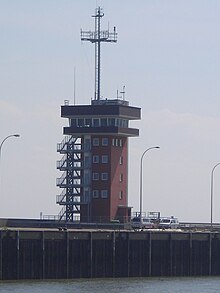
New outer harbor
The new outer harbor was built between 1959 and 1964 as an approach to the fourth entrance. It is home to the Heppenser Groden naval base, the largest base of the German Navy . There are permanent berths and swimming piers on both sides of the port. The base is the home port of frigates and supply ships of the Operational Flotilla 2 and houses other military offices. In addition, the port is used as a berth by civil authorities and tugs.
Construction port
The construction port is the oldest part of the Wilhelmshaven port facilities. It houses the naval arsenal with workshops and floating docks . The construction port can be reached from the equipment port via an entrance (→ port canal ), which is spanned by a bascule bridge, the Jachmann Bridge. It is used exclusively by the Navy. The naval arsenal has a number of workshops and a floating dock that can accommodate ships up to 8,000 tons.
Inland ports
Most of the inland ports originally served the needs of the Navy. Today they form the city port with handling facilities, pleasure craft berths, shipyards, repair shops and other port service providers.
North harbor
The north port was built in the course of the 3rd construction phase from 1898 and was expanded during the 4th construction phase (→ Nordwerft ). It is located immediately south of the fourth entrance. After the Second World War, the north port was largely destroyed and remained largely unused until the 1970s. Only years later began the clearing of rubble and the construction of new port facilities. The former Dock VIII was expanded into a side basin, where the Neue Jadewerft has been located as the only larger shipyard in Wilhelmshaven since the 1980s .
The company Jade Werke GmbH , which belongs to the Chinese Hantong Group, intended to build a production facility for the foundations of wind turbines at the northern harbor, which should be shipped from there to their locations. The construction of the facility between the New Jade Shipyard and the port of equipment should begin in August 2012. Before that, two old bunkers were demolished on the site. In April 2014, the Chinese parent company ended the project because the conditions for the construction of offshore wind turbines had deteriorated.
The inner quay on the east side serves the Navy as a berth for large supply ships. In addition, the north port has several quays , transshipment facilities, recreational boat berths and two dolphin berths for trailers .

Equipment port
The equipment port was created during the 1st construction phase as a port canal between the II. And III. Driveway and the construction port. It forms a central port basin between the north port in the north, the construction port in the west and other parts of the inland port in the south-west. The equipment port only has a quay used by the naval arsenal on the north side, otherwise only berths on dolphins .
Connection port
The connecting port adjoins the equipment port in the southwest and connects it with the port facilities that were built in the third construction phase. On its north-west side, the part of the former port canal forms its own port basin. There are the Nordwestkai with a RoRo Plant and in the Harbor Island preferred Nordostkai , which serves as a repair operation of mooring. The Südwestkai is a general transshipment facility for ships with a draft of up to 10 meters. On the south side of the connecting port (see also the torpedo yard) is the barrel yard in the area of the approach to the former first entrance. To the west of it is the German Naval Museum. The western end of the connecting port is the passage to the Great Harbor, which is spanned by the Kaiser Wilhelm Bridge .
Great port
The large port connects to the connecting port in the west. On its south side it is separated from the Jade Bay by the Fliegerdeich . In this area there are recreational boat berths and yards. In the southwest, the Grodendamm closes the passage to the former parts of the port, which today form the Banter See . Several companies and the naval magnetic measuring point are located on the Wiesbaden Bridge to the north . The cable loops belonging to this measuring point for the magnetic measurement and treatment of warships are located in the middle part of the harbor basin .
The Bontekai , Wilhelmshaven's harbor promenade, extends to the north of the Great Harbor . Here are some museum ships and guest boaters. In the northwest, north of the Wiesbaden bridge, the Ems-Jade Canal flows into the Wilhelmshaven ports. The dike bridge spanning it is the western boundary of the Great Harbor.
Commercial port
The trading port lies between the dike bridge and the Rüstringer bridge on both sides of the Ems-Jade Canal. It was built during the 2nd construction phase and is the oldest civil part of the port. The companies Interseroh Jade-Stahl, MWB Motorenwerk Wilhelmshaven and, in future, the Harbers shipyard are located at the commercial harbor .
Canal port
The canal harbor was created during the 3rd construction phase by widening the Ems-Jade Canal. It only has dolphin berths for occasional trailers . It is no longer used economically. On its west side is the Mariensiel lock , which forms the entrance to the actual Ems-Jade Canal.
References
Web links
- Overview at wilhelmshaven-port
- Overview of the Wilhelmshaven port facilities p. 13 ff. (PDF file; 3.3 MB)
- Wilhelmshavener Hafenwirtschafts-Vereinigung eV ("WHV")
See also
literature
- Gerhard Koop, Erich Mulitze: The Navy in Wilhelmshaven - A pictorial chronicle of German naval history from 1853 to today . 2nd, updated and expanded edition / special edition. Bonn 1997, ISBN 3-7637-5977-8 .
- Ralf Witthohn: Deep water trump card . In: Deutsche Seeschifffahrt. Storck-Verlag, Hamburg 2010, ISSN 0948-9002 , issue 11/2010, pp. 46-49.
- Wilhelmshavener Heimatlexikon . Vol. 1-3, Wilhelmshaven 1986/1987.
Individual evidence
- ↑ Eckhard-Herbert Arndt: Tailwind for box envelope on the Jade . In: Daily port report of March 7, 2018, p. 4
- ^ Peter Kleinort: Economic reconstruction weighs on ports . In: Daily port report of February 28, 2017, p. 3
- ↑ Lower Saxony invests in its ports . In: Hansa , issue 4/2016, p. 92/93
- ↑ Differentiated picture in the development of the envelope . In: Schiff & Hafen , issue 4/2014, pp. 44–47, here p. 47
- ↑ Eckhard-Herbert Arndt: Ports want to grow sustainably . In: Daily port report of February 17, 2015, p. 3
- ↑ A big plus for JadeWeserPort . In: Deutsche Seeschifffahrt (Ed. Verband Deutscher Reeder eV), March / April 2016 issue, p. 34
- ^ Peter Kleinort: Less handling in Lower Saxony's ports . In: Daily port report of February 28, 2017, p. 1
- ↑ Eckhard-Herbert Arndt: Tailwind for box envelope at the Jade · Tiefwasserhafen benefits from the re-formation of the large alliances . In: Daily port report of March 7, 2018, p. 4
- ^ Eckhard-Herbert Arndt: Lower Saxony's ports are growing . In: Daily port report of February 13, 2020, p. 1
- ↑ Art. 53 para. 2 of the Imperial Constitution
- ↑ a b c d Wilhelmshavener Heimatlexikon . Vol. 1-3, Wilhelmshaven 1986/1987
- ↑ Gerhard Koop, Erich Mulitze: The Navy in Wilhelmshaven .
- ↑ a b Wilhelmshavener Zeitung of November 11, 2009, p. 8
- ↑ Feasibility study by WSD Northwest from 1999
- ^ Wilhelmshavener Zeitung, May 3, 2008
- ^ Wilhelmshavener Zeitung of February 11, 2010
- ↑ Stadtwerke Verkehrsgesellschaft Wilhelmshaven mbH: Port Operations of the City Port of Wilhelmshaven ( Memento of the original from October 8, 2013 in the Internet Archive ) Info: The archive link was inserted automatically and has not yet been checked. Please check the original and archive link according to the instructions and then remove this notice.
- ↑ a b Club and ships are covered . In: Wilhelmshavener Zeitung of February 19, 2013, p. 7.
- ↑ Stadtwerke Verkehrsgesellschaft Wilhelmshaven mbH: Portrait of the city port of Wilhelmshaven ( Memento of the original from May 9, 2014 in the Internet Archive ) Info: The archive link was inserted automatically and has not yet been checked. Please check the original and archive link according to the instructions and then remove this notice.
- ↑ Niedersachsenports: Port of Wilhelmshaven - overview and port plans ( Memento of the original from September 22, 2012 in the Internet Archive ) Info: The archive link was automatically inserted and not yet checked. Please check the original and archive link according to the instructions and then remove this notice.
- ↑ Niedersachsenports: organizational structure of Niedersachsenports
- ↑ Nord-West Oelleitung: Overview and aerial photo of the port ( Memento from July 3, 2013 in the Internet Archive )
- ↑ Delay in JadeWeserPort - start only at the end of September at focus.de, June 5, 2012 (accessed on June 5, 2012)
- ↑ The port captain should remove scrap . In: Wilhelmshavener Zeitung of July 8, 2014, p. 3.
- ↑ Ordinance on the administration and organization of the sea pilot areas Weser I and Weser II / Jade (Weser / Jade-Lotsverordnung - Weser / JadeLV) of February 25, 2003 of the Waterways and Shipping Directorate Northwest (PDF; 50 kB)
- ↑ Overview of port service providers at Ports of Wilhelmshaven
- ↑ Wilhelmshavener Zeitung of July 30, 2009
- ^ Gisela Schütt: The coastal motorway A 20. Lower Saxony State Authority for Road Construction and Transport, June 14, 2011, accessed on June 18, 2011 .
- ↑ a b Rail expansion can continue . In: Wilhelmshavener Zeitung of January 30, 2012, p. 1
- ↑ Chance on west track not yet built . In: Wilhelmshavener Zeitung of June 5, 2012, p. 3.
- ↑ Northern connection of the inner port of Wilhelmshaven. Lower Saxony state authority for road construction and traffic: http://www.strassenbau.niedersachsen.de/portal/live.php?navigation_id=21073&article_id=78360&_psmand=135
- ^ INEOS jetty at Ports of Wilhelmshaven
- ^ Refinery pier at Ports of Wilhelmshaven
- ↑ http://www.ndr.de/regional/niedersachsen/oldenburg/jadeweserport783.html ( Memento from September 24, 2012 in the Internet Archive )
- ^ Lower Saxony bridge at Ports of Wilhelmshaven
- ↑ Double premiere in Wilhelmshaven . In: Daily port report of March 25, 2015, p. 3.
- ↑ a b Wilhelmshavener Zeitung of April 20, 2011, p. 8, teaser
- ↑ fri-tv.de: E.ON stops planning for Kraftwerk 50plus , accessed on January 2, 2012
- ↑ First coal giant on the Jade and, step by step, coal into the hinterland . In: Wilhelmshavener Zeitung of November 6, 2012, p. 1/5
- ↑ Russian coal at BTW . In: Daily port report from June 4, 2014, p. 4
- ↑ Ulrich Müller-Heinck: Port of Wilhelmshaven: Crane can grab 44 tons of coal at once. ( Page no longer available , search in web archives ) Info: The link was automatically marked as defective. Please check the link according to the instructions and then remove this notice. NWZonline.de, August 2, 2011, accessed January 2, 2012
- ↑ New cranes installed on the Lower Saxony bridge. NWZonline.de, September 21, 2011, accessed January 2, 2012
- ↑ a b Lower Saxony Ministry of Economics, Labor and Transport: Lower Saxony Bridge with a new level of performance: handling facility in Wilhelmshaven inaugurated . April 11, 2012, accessed October 2, 2012
- ↑ Michael Hollmann: More coal for much more coal . In: Hansa , Schiffahrts-Verlag Hansa, Hamburg 2012, ISSN 0017-7504 , issue 5/2012, p. 78/79.
- ↑ Railway closure slows down coal imports. In: Wilhelmshavener Zeitung. January 11, 2012, p. 5.
- ^ NWO oil port at Ports of Wilhelmshaven
- ↑ Contract for Jade Werke perfect , and Rhenus Midgard wants to lure further companies. In: Wilhelmshavener Zeitung. April 25, 2012, pp. 1, 3.
- ↑ Assembly and bunker demolition . In: Wilhelmshavener Zeitung of June 29, 2012, p. 3.
- ↑ Chinese dissolve the “Jade Works” . In: Wilhelmshavener Zeitung of April 23, 2014, p. 5.
- ↑ Equipment port at Port of Wilhelmshaven
- ↑ Interseroh pier at Port of Wilhelmshaven










